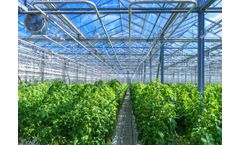Agriculture Modeling Articles & Analysis
22 articles found
This kind of precise decision-making not only improves the efficiency of agricultural production, but also helps to reduce agricultural costs and improve farmers' earnings.Fourth, realize precision agriculturePrecision agriculture is a modern agricultural management model based on modern information technology ...
ByJXCT
Extreme weather, believed to result from climate change and increased atmospheric CO2 levels, is a concern for many. And beyond extreme events, global warming is also expected to impact agriculture.1,2 Although it is expected that climate change will significantly affect agriculture and cause decreases in crop yields, the full effects of climate change on agriculture and human food supplies are ...
Low agricultural water fee collection rates are a problem commonly faced by many developing countries and this is a problem faced by China as it enters the new century. ...
We used simulation to study how three French sheep production systems could adapt to a new context created by a surge in cereal prices associated with changes in common agricultural policy support. The evaluation criteria were economic performance, energy efficiency, emissions of greenhouse gases, and sensitivity to technical and economic fluctuations. ...
The concept of our paper is based on the recognition, that environment safety and food safety is jointly influenced by the farming system and intensity of farming on the basis of given conditions. Therefore, the complete agricultural system and structure needs remodelling in order to create a management that is based on the sensitivity, stress-counteracting ability, production ...
The plan is focused on biosaline agriculture. The distinctive macro–project components are: Lake Eyre is gradually filled to a higher level by controlling evaporation and by pumping seawater from the nearby ocean using cheap tensioned textile tubes. ...
Society now expects agriculture to fulfil new functions to improve quality of life. This requirement has been reinforced by recent crises. The 1999 French Agricultural Framework Law (LOA) formalised agricultural multifunctionality and included payments to farmers for new practices, which satisfy both social and environmental functions, in ...
This paper presents a mathematical programming model for farm planning in agricultural areas that are sensitive to nitrates. ...
This evolution has concurred to strengthen the idea that agriculture as a means of ensuring environment protection is not the kind of agriculture that carries out production activities, but one that carries out conservation tasks. In this frame, the interventions to support agriculture's environmental role should no longer be considered a sort of ...
In this paper, the calibration and prediction capacity of a supply response positive mathematical programming model (PMP) for the Alentejo region are evaluated. The model is calibrated with prices and agricultural subsidies of the base year (2000), using the specification rules of the cost function standard, Paris standard, average cost and ...
Selecting cost-effective measures to regulate agricultural water pollution to conform to the Water Framework Directive presents multiple challenges. A bio-economic modelling approach is presented that has been used to explore the water quality and economic effects of the 2003 Common Agricultural Policy Reform and to assess the cost-effectiveness ...
In this paper, the impact of full liberalisation of world cotton markets on Sudan and some selected African countries was estimated. Last version of Agricultural Trade Policy Simulation Model was applied. The results indicate that the liberalisation of cotton markets will lead to an increase in the world market price of cotton, which will have positive impact on ...
The farm level spatial microsimulation model developed in this paper uses one of many combinational optimisation techniques – simulated annealing – to match the Irish Census of Agriculture to the 2005 Irish National Farm Survey (NFS). Using the new spatially disaggregated farm population microdata this paper then briefly analyses the impact of future Common ...
The main objective of this review was to determine whether DON losses from agricultural systems are significant, and to what extent they pose a risk to human health and the environment. Dissolved organic N losses across agricultural systems varied widely with minimum losses of 0.3 kg DON ha–1yr–1 in a pasture to a maximum loss of 127 kg DON ha–1yr–1 in a ...
Multifunctionality of Agriculture (MFA) is a concept that supports the recognition of complex interdependencies between different resources, production processes and outputs of agricultural land use. ...
Turkey has a particular interest in the WTO agricultural negotiations in view of its significant agricultural sector. This paper undertakes a quantitative analysis of trade liberalisation and its impact on Turkish agriculture. We use UNCTAD's Agricultural Trade Policy Simulation Model (ATPSM). ...
This paper addresses the potential consequences of a political and economic integration of EU and Turkish agriculture and evaluates the resulting challenges. Simulation models reveal declining agricultural prices for Turkey in the case of market integration with the EU. This would lead to less production, more consumption and Turkey becoming a ...
The framework is applied to characterise the information structure underlying the agricultural innovation system of Azerbaijan and to develop an information strategy for the system to accelerate the information flow. The key institutions required to promote and support an effective flow of information in innovation systems are also discussed.Keywords: Azerbaijan, innovation ...
The main contribution of this paper is to present a Contingent Valuation (CV) modelling approach that allows for the calculation of a net willingness to pay when both 'lovers' and 'haters' of these GM crops are considered. ...
This case helps the understanding of particular phenomena in agricultural risk management: The EU governance system aims for price competitive quality food, and controls the producer indirectly, delegating the essential control functions to national authorities that delegate to the controller, who in turn is also the key to over-medication and hence risk taking. The farmer ...





